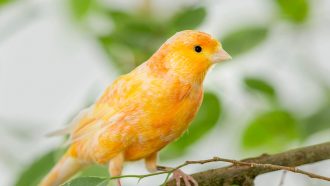
For canaries, just seeing their feathered friends get sick may be enough to preemptively rev up their immune systems.
Healthy birds housed within view of fellow fowl infected with a common pathogen mounted an immune response, despite not being infected themselves, researchers report online June 9 in Biology Letters.
“It’s fascinating that some sort of visual cue could alter immune function,” says Ashley Love, a disease ecologist at the University of Connecticut in Storrs. Precisely how much these alterations actually protect the birds remains unclear, she says.
Immune systems are like sentinels, patrolling the body for invaders and calling in the cavalry once a pathogen is detected. Traditionally, pathogens have to actually get into bodies to spur that sort of response.
But some research has previously hinted that perceived threats can whip up immune cells. For example, one experiment in humans found that a mere photo of a sick person increases the activity of inflammation-stimulating chemicals called cytokines. But no one had ever looked to see whether being within eyeshot of an actually sick individual could compel the immune system to preemptive action, Love says.
“A lot of wildlife diseases have these obvious physical symptoms,” she says. If wild animals can prepare, immunologically, at the first sign they might become infected, they may be better equipped to fight off the invader once it comes.
To test this idea, Love and her colleagues infected 10 caged canaries (Serinus canaria domestica) with Mycoplasma gallisepticum, or MG, a common bacterial pathogen that causes conjunctivitis and extreme lethargy. Sick birds look “pretty fluffed out,” Love says.
Nine healthy birds were housed in direct view of their sick brethren, but far enough away to avoid infection, which requires direct contact. An identical setup, but with all healthy birds, was located in the same room but on the other side of an opaque divider. Over the course of a month, researchers collected blood samples from the birds, measured various aspects of immune activity and tracked how sick the infected birds looked.
As healthy birds witnessed neighbors becoming visibly sick, their immune systems stirred. A measure of the birds’ ability to burst foreign cells, called CH50 complement activity, rose in conjunction with how sick the infected birds appeared. White blood cell counts were also significantly different in birds exposed to sick individuals, rather than healthy ones. Cytokine levels did not differ between the two groups.
Blood tests showed that no healthy birds caught MG during the experiment, suggesting that some sort of external cue altered immune function. That cue was likely visual, Love says. The smells and sounds of the sick could reach all birds in the experiment, but only the birds in direct view of the ill birds showed an immune response.
“This was a pretty convincing study,” says Dana Hawley, a disease ecologist at Virginia Tech in Blacksburg who wasn’t involved in the research. Lots of animals avoid infection by social distancing, she says. For instance, lobsters steer clear of dens occupied by sick individuals, and the house finches that Hawley studies avoid individuals who appear ill.
But social distancing has its costs, especially for highly social species.
For species that forage together, or rely on safety in numbers, ramping up an immune response at the mere sight of illness might confer some protection while still allowing the animals to get up close and personal.
“It’s great to avoid a pathogen,” Hawley says, “but if you can’t find food or [you] get taken by a predator, it doesn’t really matter.”


